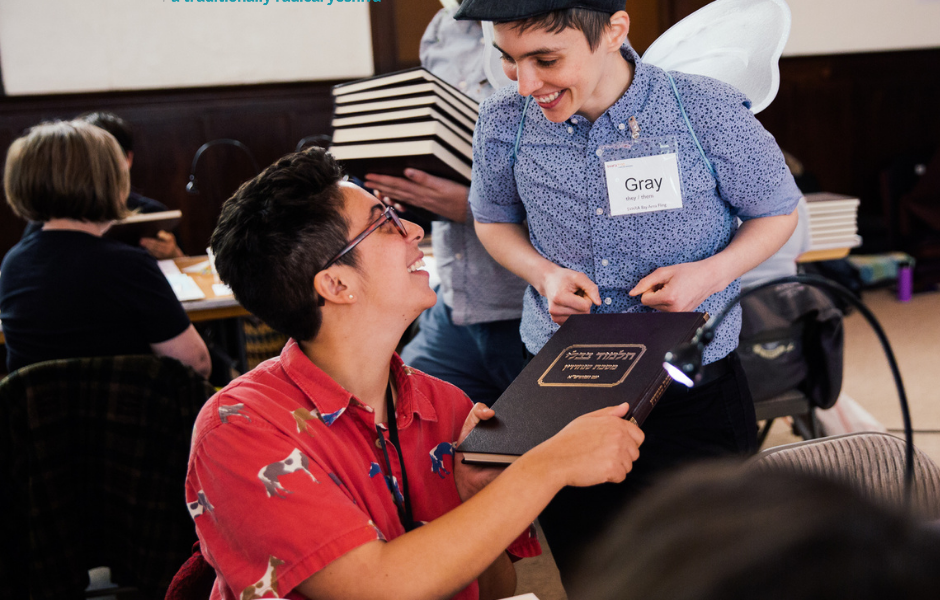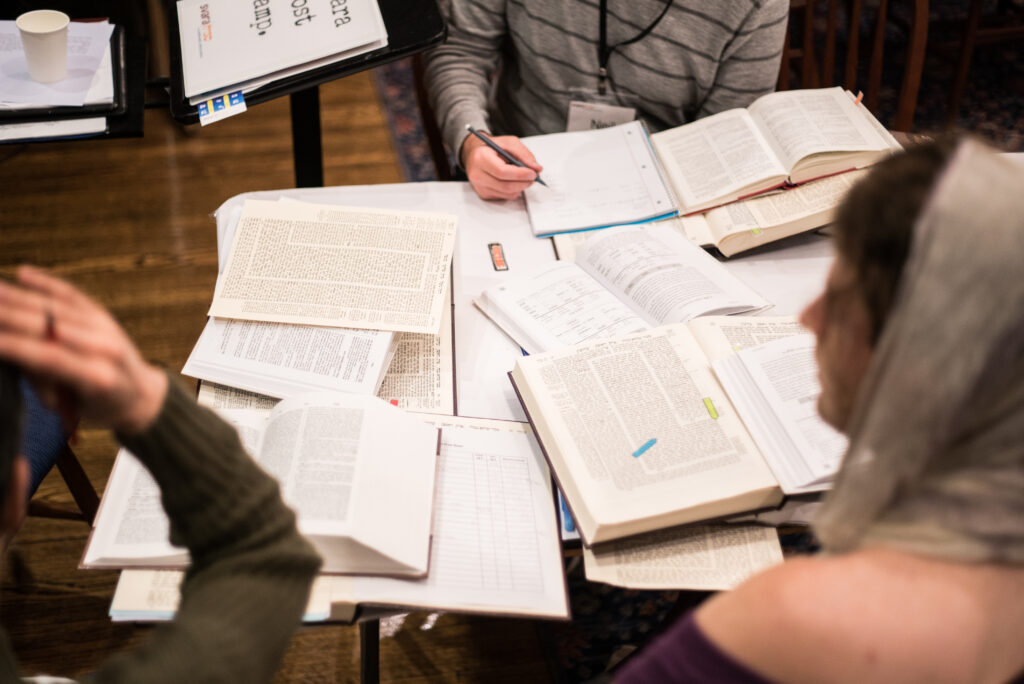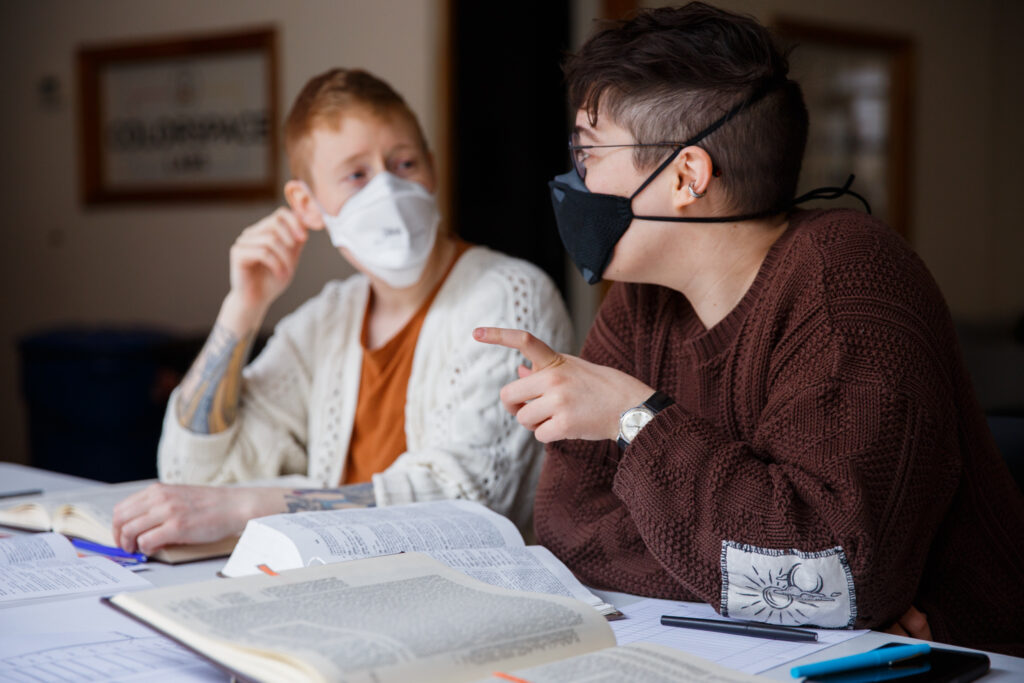Teachers have always set me on edge. In third grade I was labeled a “gifted underachiever.” I’m not quite sure precisely what I did to warrant that designation as an eight year-old (though I will easily admit my contrarian ways!), but it followed me through high school as I was tracked in “remedial” classes throughout my education. I experienced teachers as a symbol for capriciously distributed power—people to whom I owed respect and obedience without their having earned it.
Schooling has been a source of pain, anxiety, and anger for me, so it’s strange that the places in which I’ve found the most joy are learning and teaching. Education is so often centered around a “banking” model [1] and approach that treats learners like deposit-boxes in which to place information from teachers on-high.
Talmud can be learned and taught with methods that reinforce this approach, nurture existing hierarchies, and maintain the status quo of patriarchal power and literacy (“I don’t know enough,” “You need to know X before you can Y,” “Who are you to interpret the text?!”). This is how Talmud has been taught for millennia. But it doesn’t have to be.
Despite being taught most commonly and conventionally in ways that maintain the status quo and normative systems of power and patriarchy, I’ve always felt like Talmud itself rejects those forms of power. All the more so I’ve experienced this at SVARA, where we bring attention to our learning processes as tools for creating people who are equipped and resilient enough to subvert normative hierarchies—in and beyond the bet midrash.
What is it about the way we do Talmud that enables me to really learn?
At our first gathering of fellows in SVARA’s Teaching Kollel in the fall of 2018, we learned a sugya about Rabbi Hiya, a sage who we see as one of the earliest SVARA teachers. In Masechet Bava Metzia, our Sages tell the tale of two rabbis, Rabbi Hanina and Rabbi Hiya, who were Torah comrades, learning in chevruta together and often disagreeing (as chevrutot can be known to do!). When their debates would reach a peak, Rabbi Hanina would declare his superiority by saying to his friend, “Do you dare to debate with me?! If, G!d forbid, the Torah were forgotten by the Jewish people, I myself could restore it alone through my powers of analysis and intellectual acumen!” Rabbi Hiya would respond, “Do you dare to debate with me? I prevent the Torah from being forgotten by the Jewish people in the first place!”
Rabbi Hanina puts himself out there as a supreme expert in learning and Talmud, with the ability to restore all of the Torah’s arguments all by himself. For Rabbi Hiya, none of Rabbi Hanina’s intellectual acumen has any relevance. Rabbi Hiya prevents the Torah from being forgotten altogether! Rabbi Hiya’s power, though, is not in what he knows—it’s what he does:
מאי עבידנא אזלינא ושדינא כיתנא וגדילנא נישבי וציידנא טבי ומאכילנא בשרייהו ליתמי ואריכנא מגילתא וכתבנא חמשה חומשי וסליקנא למתא ומקרינא חמשה ינוקי בחמשה חומשי ומתנינא שיתא ינוקי שיתא סדרי
ואמרנא להו עד דהדרנא ואתינא אקרו אהדדי ואתנו אהדדי ועבדי לה לתורה דלא תשתכח מישראל
What do I do? I go and sow flax and weave nets [with that flax], and I hunt deer and feed their meat to orphans. I prepare parchment from the hides and I write the five books of Torah on them. I go out to a town and teach five children the five books, and I teach six [other] children the six orders of the Mishna, and I say to all of them: Until I return, read each other the Torah and teach each other the Mishna.
This is how I act to ensure that the Torah will not be forgotten by the Jewish people.
(Bava Metzia 85b)
Rabbi Hiya takes a process-oriented approach to teaching and learning. He travels to the towns on the outskirts of the city to find groups of young children. To each child, he teaches one of the five books of the Torah, and to another group, he teaches each child one of the six orders of the Mishnah, saying to both groups, “Until I return, each of you should teach each other what you know.” But Rabbi Hiya knows full well he will never return.
The key to the survival of the tradition, according to this talmudic tale, happens when Rabbi Hiya takes a back seat and puts his students in charge of their own learning. Unlike his adversary, Rabbi Hanina, who offers a vision of leadership that relies on a singular expert-scholar, Rabbi Hiya actually ensures the flourishing of Torah by getting out of the way. His insights, intellectual acumen, and personal expertise are de-centered in this story, which offers an alternative that we—as Fellows, Fairies, and teachers—strive always to embody in our learning and teaching.
Rabbi Hiya is my Talmud teaching hero. A true SVARA-nik at heart. He offers a model for process-oriented, democratic education, creating the space for us as teachers committed to liberatory approaches to education to find reflections of ourselves in our tradition. Learning about his teaching—and his attention to every detail and process that enables it, from planting flax seeds to stretching hides for parchment—offered me a window into my own aspirations as a teacher, along with our dreams at SVARA for what teaching can look like.
Rabbi Hiya created a learning space in which learners teach each other. Each student takes the piece of the Torah that is theirs—a book, a section of the mishnah—and teaches their comrades what they have learned. At the center of this model is an investment in a practice of democratized learning in which teachers are not experts but are a chevruta who is just a few steps ahead. Rabbi Hiya teaches his students, who are then tasked with teaching each other. Each student is not a scholar or an expert in the single book that they’ve learned. What qualifies them to teach this material is that they’ve learned it; all they need to do is show their friends what they’ve learned and how they learned it, making their learning public.
As teachers in the SVARA bet midrash, we try to do the same. Our task—for ourselves and for all SVARA-niks—is to take what we’ve learned in chevruta and to show our work, offering ourselves and our learning to the future players who learn in the bet midrash with us. We say over and over: “We don’t care if you know what the word means. We care that you know how the word means what it means.” In other words, it’s not what you know—it’s how you know it. This oft-stated mantra in the bet midrash is the invitation to take what we know and make our processes for getting from here to there as transparent as possible. Each time we call on a reader who explains how they figured out the root in chevruta, or how they came up with an outrageously poetic inside translation that turns the whole text upside down, we are doing Rabbi Hiya’s work, creating a world in which the Torah can never be forgotten. It’s this practice of turning a text inside and out, of teaching and learning from each other, that leads us to ownership—of our learning and of the tradition, inhabiting a new model for education that has the power to transform us all.
[1] See Paulo Friere’s essay “The Banking Model of Education” in Critical Issues in Education (2006).







